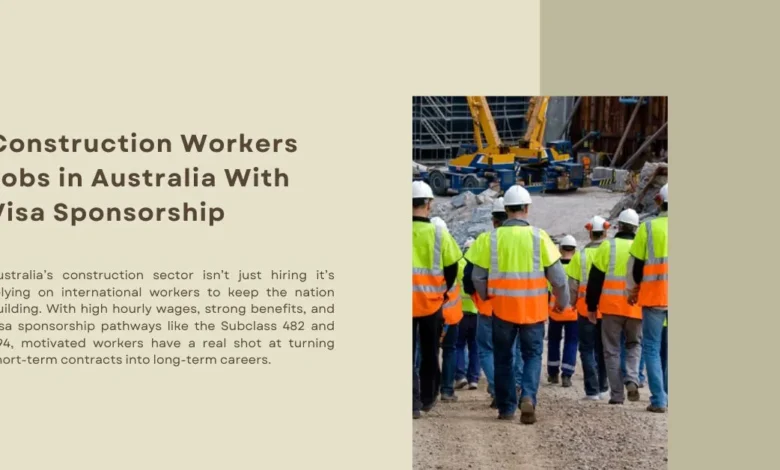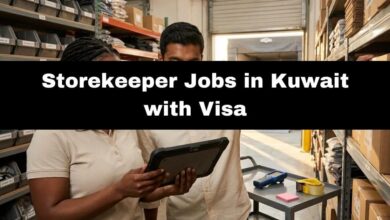Construction Workers Jobs in Australia With Visa Sponsorship

Imagine working under the bright Australian sun on landmark projects that shape the skyline of cities like Sydney and Melbourne. Australia’s construction industry is in the midst of an unprecedented boom, but a critical shortage of skilled hands means opportunities for international workers have never been greater.
From high-rise apartments to vital infrastructure in remote regions, employers are actively seeking dedicated individuals and are ready to sponsor their visas. You don’t need a university degree; you need a strong work ethic, physical fitness, and a willingness to learn.
With some of the highest wages in the world, offering $27 to $45 per hour, plus benefits like overtime and retirement savings, this is more than a job it’s a pathway to a stable and rewarding career. If you’re ready to build, create, and secure your future, Australia is calling.
The Skills Shortage: Why Australia Needs You
A generational shift has seen many Australians pursue careers in technology and service industries, leaving a substantial gap in the building trades. This shortage is most acute in:
- Skilled Trades: Bricklaying, Carpentry, Plumbing, Formwork
- Critical Roles: Scaffolding, Concreting, Steel Fixing
- Machine Operation: Excavator, Crane, and Forklift Operators
- General Labor: Site assistants, laborers, and trade helpers
From the skylines of Sydney and Melbourne to the remote resource projects in Western Australia and Queensland, employers are actively seeking international talent and are prepared to sponsor visas for the right candidates.
Read Also: General Labourer Jobs in Australia with Visa Sponsorship
Available Construction Roles
Opportunities exist for all skill levels, from entry-level laborers to highly specialized tradespeople.
| Role | Typical Responsibilities |
|---|---|
| General Labourer | Moving materials, site cleaning, assisting tradespeople. |
| Concrete Worker / Steel Fixer | Pouring, finishing, and reinforcing concrete structures. |
| Bricklayer / Blocklayer | Constructing walls, foundations, and other brick/blockwork. |
| Carpenter / Formworker | Building frames, formwork for concrete, and installing fixtures. |
| Machine Operator | Safely operating excavators, bulldozers, forklifts, and cranes. |
| Scaffolder | Erecting and dismantling temporary access and safety structures. |
| Plumber / Pipefitter | Installing and maintaining water, gas, and drainage systems. |
Many entry-level positions provide on-the-job training, while skilled roles require proven experience and often formal qualifications.
Salary & Benefits: What to Expect
Australian construction wages are among the most competitive in the world, offering a high standard of living.
2025 Salary Expectations (Full-Time, Approximate):
- General Labourer: $27 – $32 AUD per hour ($1,100 – $1,300 weekly)
- Skilled Labourer / Trades Assistant: $30 – $38 AUD per hour ($1,300 – $1,500+ weekly)
- Qualified Tradesperson (Carpenter, Bricklayer): $35 – $45 AUD per hour ($1,400 – $1,800 weekly)
- Machine Operator: $33 – $42 AUD per hour ($1,300 – $1,700 weekly)
Additional benefits often include:
- Overtime and penalty rates for weekend/night work
- Travel and site allowances
- Employer contributions to superannuation (retirement fund)
- Paid annual and sick leave (for permanent roles)
- Provision of personal protective equipment (PPE) and tools
- Accommodation or allowances for remote work
Eligibility & Requirements
The barriers to entry are focused on practical ability and reliability rather than formal academia.
Basic Criteria:
- Be at least 18 years of age.
- Be physically fit and able to work outdoors in various conditions.
- Have a strong commitment to workplace health and safety.
- Be willing to work shifts, including weekends when required.
- Possess a basic understanding of English to follow instructions safely.
- Have a clean criminal record.
For Skilled Roles: Relevant experience and formal certifications (e.g., a trade qualification) are typically mandatory.
Visa Sponsorship Pathways
Understanding the correct visa is crucial for a legal and successful application.
1. Temporary Skill Shortage (TSS) Visa (Subclass 482)
- The most common pathway. An employer sponsors you for a specific role for up to 4 years.
- Your occupation must be on the relevant skilled occupation list.
- Requires at least 2 years of relevant work experience.
2. Skilled Employer Sponsored Regional (SESR) Visa (Subclass 494)
- For jobs located in designated regional areas (outside major cities like Sydney, Melbourne, Brisbane).
- A pathway to Permanent Residency after 3 years of living and working in the region.
- Excellent option due to high demand in regional Australia.
3. Working Holiday Visa (Subclass 417 / 462)
- For applicants aged 18-30 (or 35 for some countries) from eligible nations.
- Allows you to work for any employer, typically for up to 6 months at a time.
- A popular way to gain Australian work experience, often in labouring roles.
Where are the Jobs Located?
Major opportunities are concentrated in key growth regions:
- New South Wales: Sydney (high-rise construction, metro rail projects)
- Victoria: Melbourne (infrastructure expansion, commercial building)
- Queensland: Brisbane and Gold Coast (roads, bridges, residential housing)
- Western Australia: Perth (mining and resource-related construction)
- Northern Territory: Darwin (remote infrastructure and defence projects)
Pro Tip: Applicants willing to work in regional or remote areas significantly increase their chances of securing visa sponsorship, often with higher pay and benefits.
How to Apply For Construction Workers Jobs in Australia With Visa Sponsorship
Follow this plan to navigate the application process effectively.
Step 1: Prepare Your Documents
- An updated resume/CV in English, detailing all relevant experience.
- A clear passport scan.
- Reference letters or certificates of employment from previous employers.
- Educational or trade qualifications (translated into English if necessary).
- Licenses and Certifications (e.g., White Card, forklift license, etc.).
- Police Clearance Certificate and basic health check results.
Step 2: Search on the Right Platforms
Use major Australian job portals with specific keywords:
- Recommended Sites: Seek.com.au, Indeed Australia, Jora.
- Government Portals: JobActive.gov.au
- Effective Search Terms: “Sponsorship construction labourer,” “482 visa bricklayer,” “Skilled migrant construction jobs Australia.”
Step 3: Target Approved Sponsors
Research and apply directly to large construction firms known for hiring internationally. Key companies often include:
- CPB Contractors
- John Holland Group
- Laing O’Rourke
- Multiplex
- Hutchinson Builders
Conclusion:
For hardworking individuals with construction skills, Australia offers a legitimate and rewarding career path with clear routes for visa sponsorship. By presenting yourself as a reliable, safety-conscious candidate and targeting the right employers, you can secure a role in one of the world’s most dynamic construction markets.
Frequently Asked Questions
-
What is the first step to getting a sponsored visa?
The first step is to secure a formal job offer from an Australian employer who is approved to sponsor workers. You cannot apply for a Subclass 482 visa without a sponsor.
-
Is the Working Holiday Visa a good option for construction work?
Yes, it is an excellent way to enter the Australian job market, gain local experience, and potentially find an employer willing to sponsor you for a longer-term visa like the 482.



